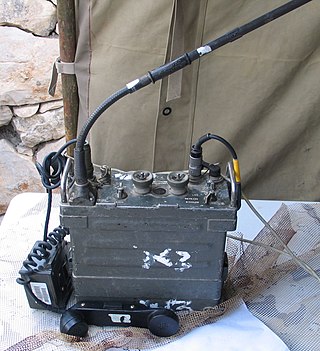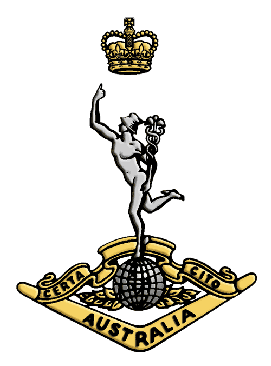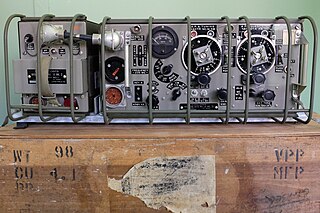
The Namibian Defence Force (NDF) comprises the national military forces of Namibia. It was created when the country, then known as South West Africa, gained independence from apartheid South Africa in 1990. Chapter 15 of the Constitution of Namibia establishes the NDF and defines its role and purpose as, " ... to defend the territory and national interests of Namibia".

AN/PRC 77 Radio Set is a manpack, portable VHF FM combat-net radio transceiver manufactured by Associated Industries and used to provide short-range, two-way radiotelephone voice communication. In the Joint Electronics Type Designation System (JETDS), AN/PRC translates to "Army/Navy, Portable, Radio, Communication."

Marine VHF radio is a worldwide system of two way radio transceivers on ships and watercraft used for bidirectional voice communication from ship-to-ship, ship-to-shore, and in certain circumstances ship-to-aircraft. It uses FM channels in the very high frequency (VHF) radio band in the frequency range between 156 and 174 MHz, designated by the International Telecommunication Union as the VHF maritime mobile band. In some countries additional channels are used, such as the L and F channels for leisure and fishing vessels in the Nordic countries. Transmitter power is limited to 25 watts, giving them a range of about 100 kilometres.

The Royal Australian Corps of Signals (RASigs) is one of the 'arms' of the Australian Army. It is responsible for installing, maintaining, and operating all types of telecommunications equipment and information systems. The motto of the Signals Corps is Certa Cito and is translated as 'Swift and Sure', signifying the aim of the signal service – that communication be carried out with maximum speed and certainty. Like their British counterparts, the Royal Australian Corps of Signals' flag and hat badge feature Mercury, the winged messenger of the gods, affectionately referred to by members of the corps as "Jimmy".
Bowman is the name of the tactical communications system used by the British Armed Forces.

Clansman is the name of a combat net radio system (CNR) used by the British Army from 1976 to 2010.

Radio is the technology of communicating using radio waves. Radio waves are electromagnetic waves of frequency between 3 hertz (Hz) and 300 gigahertz (GHz). They are generated by an electronic device called a transmitter connected to an antenna which radiates oscillating electrical energy, often characterized as a wave. They can be received by other antennas connected to a radio receiver, this is the fundamental principle of radio communication. In addition to communication, radio is used for radar, radio navigation, remote control, remote sensing, and other applications.

The Wireless Set No. 19 was a Second World War mobile radio transceiver designed for use by armoured troops of the British Army. First introduced in 1940, the No. 19 began to replace the pre-war Wireless Set No. 11. Two modified versions were introduced, Mk. II in 1941 and Mk. III in 1942. An improved version from Canada was introduced in 1942 for use primarily with other forces. In British service, the No. 19 was replaced in the post-war era by the Larkspur radio system. Canadian-built No. 19s saw continued service for many years with a variety of users.
The Royal Signals trades are the employment specialisations of the Royal Corps of Signals in the British Army. Every soldier in the Corps is trained both as a field soldier and a tradesman. There are currently six different trades, all of which is open to both men and women:
The British Armed Forces operates a wide range of communications and information systems (CIS). Some of these are specialised military systems, while others are procured off-the-shelf. They fall into three main categories: satellite ground terminals, terrestrial trunk communications systems, and combat net radio systems. Every part of the British Army uses combat net radio, but only the Royal Corps of Signals and the Royal Air Force operates trunk systems and multi-channel satellite communications.
The Naankuse Foundation Wildlife Sanctuary is a wildlife sanctuary in central Namibia, situated c. 42 kilometres (26 mi) outside Windhoek. Besides the sanctuary the establishment also runs a carnivore conservation research programme, the Clever Cubs pre-primary school, and a clinic for the San people. Nǀaʼankusê is a Juǀʼhoan word that means "God will protect us", or "God watches over us." The sanctuary opened in 2007. It is run by Namibian conservationist Marlice van Vuuren and her husband Rudie van Vuuren. Naankuse is funded by voluntary donations and relies on the time of volunteers to continue its projects.

33 Signal Regiment, formerly known as 763 Communication Regiment, is a primary reserve Canadian Army unit of the Royal Canadian Corps of Signals in Ottawa, Ontario.

Torsten George van Jaarsveld is a Namibian professional rugby union footballer. He plays mostly as a hooker or flanker. He currently plays for Pro D2 side Stade Montois.
36 Signal Regiment is Reserve unit of the Canadian Army, assigned to 36 Canadian Brigade Group. It was created on 1 April 2012 after several years of planning.

The Namibian Army is the ground warfare branch of the Namibian Defence Force.
Adriaan Jacobus Van der Berg Coertzen is a South African rugby union player for Aurillac in the Rugby Pro D2 in France. His regular position is winger or fullback.
The Luftnachrichten Abteilung 350, abbreviated as OKL/Ln Abt 350 and formerly called the, was the Signal Intelligence Agency of the German Air Force, the Luftwaffe, before and during World War II. Before November 1944, the unit was the Chiffrierstelle, Oberbefehlshaber der Luftwaffe, which was often abbreviated to Chi-Stelle/ObdL or more commonly Chi-Stelle.

32 Signal Regiment is a Canadian Army primary reserve unit, part of the Royal Canadian Corps of Signals. It is the dedicated signals unit within 32 Canadian Brigade Group.
Cameron Dawson is a South African rugby union player for the Southern Kings in the Pro14. His regular position is prop.












